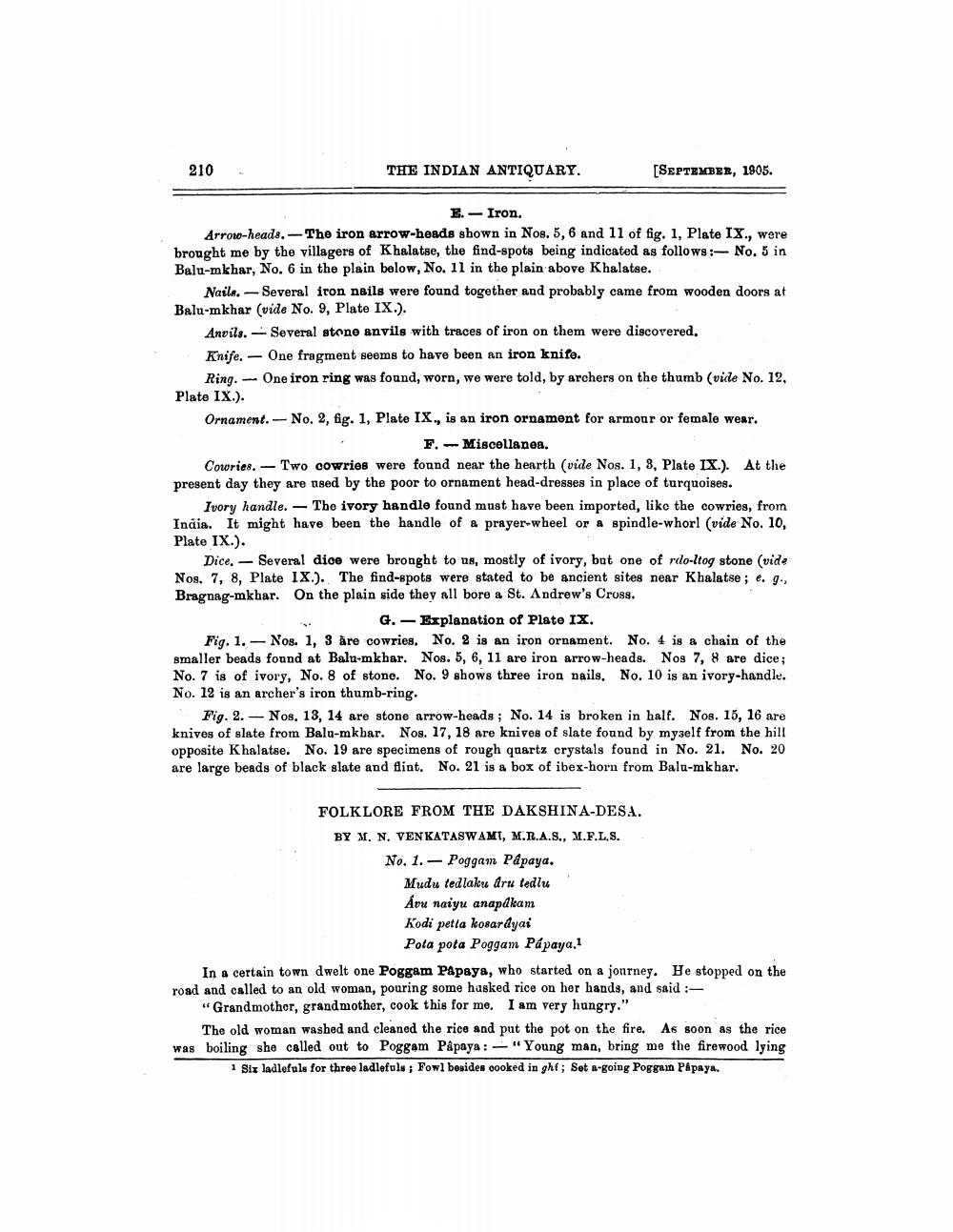________________
210
-
THE INDIAN ANTIQUARY.
[SEPTEMBER, 1905.
E. - Iron. Arrow-heads. The iron arrow-heads shown in Nos. 5, 6 and 11 of fig. 1, Plate IX., were brought me by the villagers of Khalatse, the find-spots being indicated as follows:- No. 5 in Balu-mkhar, No. 6 in the plain below, No. 11 in the plain above Khalatse.
Nails-Several iron nails were found together and probably came from wooden doors at Balu-mkhar (vide No. 9, Plate IX.).
Anvils. Several stone anvils with traces of iron on them were discovered. Knife. - One fragment seems to have been an iron knife.
Ring. - One iron ring was found, worn, we were told, by archers on the thumb (vide No. 12, Plate IX.). Ornament. -- No. 2, fig. 1, Plate IX., is an iron ornament for armour or female wear.
F.-Miscellanea. Cowries. - Two cowries were found near the hearth (vide Nos. 1, 3, Plate IX.). At the present day they are used by the poor to ornament head-dresses in place of turquoises.
Ivory handle. - The ivory handle found must have been imported, like the cowries, from India. It might have been the handle of a prayer-wheel or a spindle-whorl (vide No. 10, Plate IX.).
Dice. - Several dice were brought to us, mostly of ivory, but one of rdo-ltog stone (vide Nos. 7, 8, Plate IX.). The find-spots were stated to be ancient sites near Khalatse; e. g., Bragnag-mkbar. On the plain side they all bore a St. Andrew's Cross.
G. - Explanation of Plate IX. Fig. 1. - Nos. 1, 3 are cowries. No. 2 is an iron ornament. No. 4 is a chain of the smaller beads found at Balu-mkhar. Nos. 5, 6, 11 are iron arrow-heads. Nos 7, 8 are dice; No. 7 is of ivory, No. 8 of stone. No. 9 shows three iron nails. No. 10 is an ivory-handle. No. 12 is an archer's iron thumb-ring.
Fig. 2.- Nos, 13, 14 are stone arrow-heads; No. 14 is broken in half. Nos. 15, 16 are knives of slate from Balu-mkbar. Nos. 17, 18 are knives of slate found by myself from the hill opposite Khalatse. No. 19 are specimens of rough quartz crystals found in No. 21. No. 20 are large beads of black slate and flint. No. 21 is a box of ibex-horn from Balu-mkbar.
FOLKLORE FROM THE DAKSHINA-DESA. BY M. N. VENKATASWAMI, M.R.A.S., M.F.L.S.
No. 1. - Poggam Papaya.
Mudu tedlaku dru telu Ávu naiyu anapdkam Kodi petla kosardyai
Pola pota Poggam Pápaya. In a certain town dwelt one Poggam Papaya, who started on a journey. He stopped on the road and called to an old woman, pouring some husked rice on her hands, and said :
"Grandmothor, grandmother, cook this for me. I am very hungry."
The old woman washed and cleaned the rice and put the pot on the fire. As soon as the rice was boiling she called out to Poggam Papaya: - "Young man, bring me the firewood lying
1 Sir ladlefuls for three ladlefuls; Fowl besides cooked in ghi; Set a-going Poggam Papaya.




